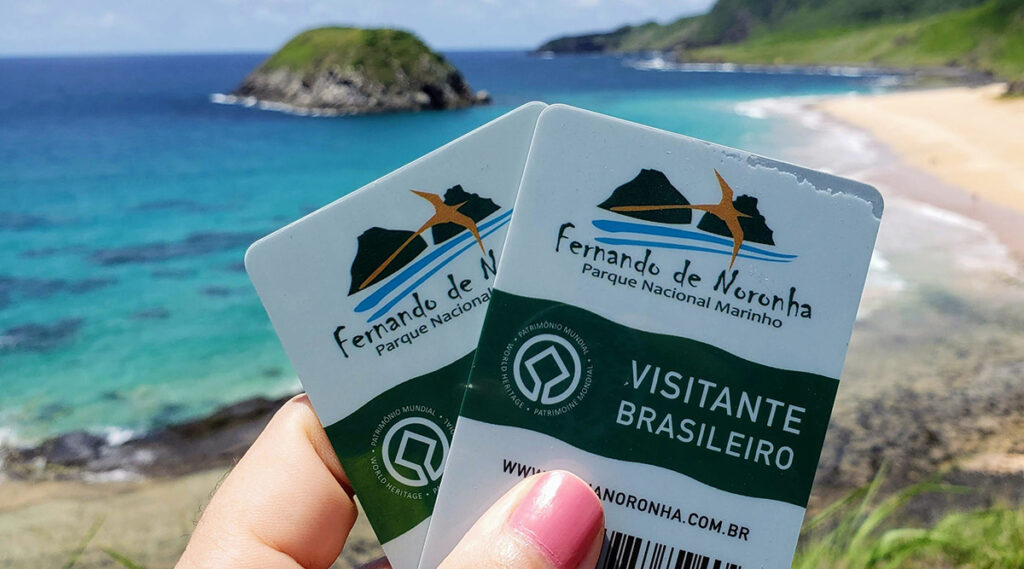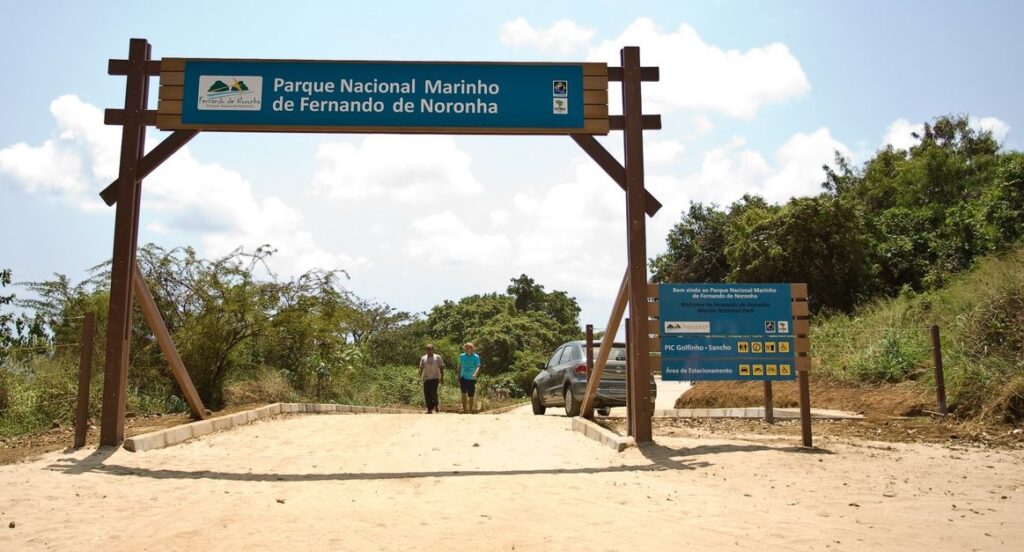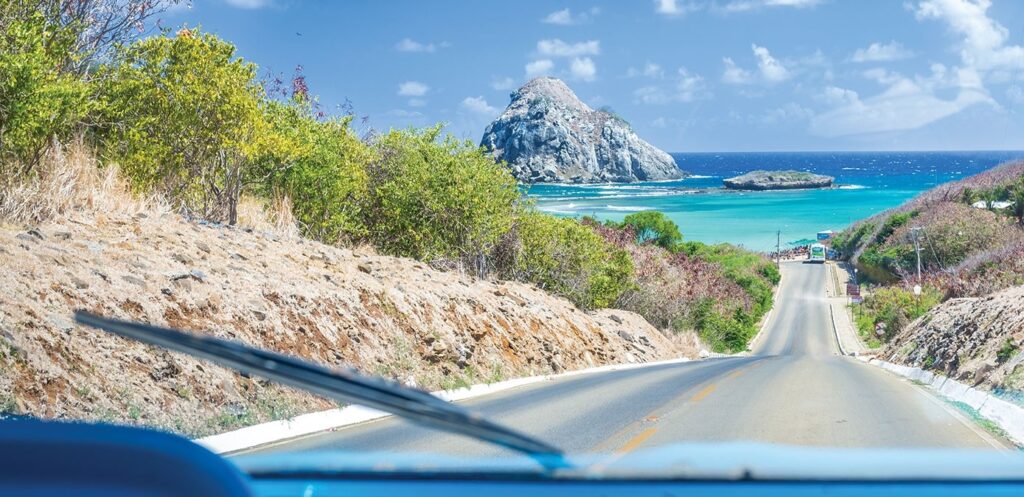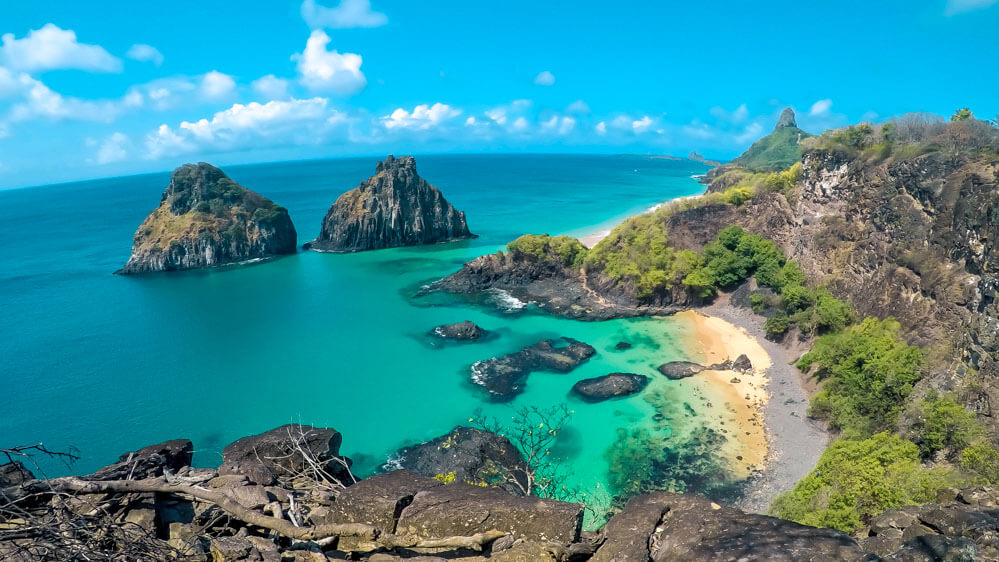Table of contents
Noronha: when to go
Safety in Fernando de Noronha
How long to stay in Noronha
Prices in the island
How to get there
Visitation fees
National Park ticket
Fernando de Noronha Airport Transfer
Fernando de Noronha: when to go
Fernando de Noronha has two seasons. The dry season runs from August to February. The rainy season lasts from March to July (the rainiest months are April, May, and June).
In addition, sea conditions must be taken into account. The wave season (swell, in the jargon of surfers and boaters) runs from mid-October to March. The season of calm sea (flat) usually goes from April to September.
See more below how the weather is month by month in Fernando de Noronha. But first, keep a summary of the best times.
- To dive: good all year round, better in August and September.
- To enjoy the beach: August and September, dry season (no rain) and the sea is quiet like a swimming pool.
- To surf: December to March, when the biggest swell comes. The best month is usually February.
- To rock: New Year’s Eve and the first two weeks of January, when the island is full of tourists and with plenty of parties around.
- To Save Money: April to June (lowest prices) or between October and December 15 (except holidays).
New Year’s Eve and January:
Good weather (rainfall below 100 mm). High waves (on beaches like Cacimba do Padre, Bode, Boldró, Conceição, and Cachorro). The snorkel is still good, but it’s necessary to move further from the shore on the beaches of Sancho, Baía dos Porcos and Porto, because the strip of the edge will be disturbed. Diving is also good, but navigation to the dive site can face rough seas.
The swell does not affect the beaches of Mar de Fora (Leão, Sueste, Atalaia), but the Sueste has less crystalline water due to the accumulation of sediments (enjoy swimming with turtles, which are more numerous at that time). It is the most expensive time on the island, and also with the greatest excitement (which extends from New Year’s Eve to jan 15).
February
In comparison with January, February has some more rain (around 100 mm, which is very little for a tropical place) and even higher waves – is the favorite month for surfers. The conditions for snorkeling and diving are the same as in January. Prices and excitement decrease slightly.
March
The rainy season begins – the average rainfall exceeds 250 mm. But the waves are still high. Prices decrease – they are already on low season levels. For those who surf, is the best value-for-money season.
The conditions for snorkeling, diving, and sea bathing remain the same as in January (but with less light for diving).
April, May, and June
Is it worth going to Noronha in the rainy season? In April and May, it rains near 300 mm. In June, rainfall drops to 200 mm. The season has three advantages: lower prices, an empty island and a calm sea.
Does it rain all the time? It rains just a little bit in the early morning or late afternoon? Or does it rain separately during the day (rain-sun-rain-sun)? It’s unpredictable. Any of these situations can happen. It’s also possible have no rain at all. The ideal at this time is to plan longer stays, to ensure as much as possible sunbathing.
With the reduction of sea foam, snorkeling can be made closer to the coast. The dive might have lower light, but it will be enough for good visibility, and navigation to the dive sites will be smoother. Praia do Cachorro, which gains stones at the time of the swell, enjoys sand again – and Noronha recovers its ‘urban beach’. But don’t get excited: in these months, the island is kind of hybrid.
July
Transition month between rainy and dry seasons, July tends to have rainfall below 150 mm – it is likely that every day will be useful, at least partially. The sea is flat, good for enjoying the beach, snorkeling and diving. Prices and volume of travelers increase due to the holidays.
August and September
For those who enjoy the beach, snorkeling, and diving, or want to go to Noronha with children, August and September are the most special months. The weather will be very good (precipitation below 50 mm) and the sea, is very quite, perfect for swimming.
Prices are almost as high as in high season – and August sees the visit of many Europeans (holiday month in Europe). If you want to find and enjoy the classic “Noronha postcards”, plan to go somewhere between these two months.
October, November, and December
The last three months of the year are the driest: it hardly rains. The beginning of October normally keeps the sea calm as in August and September. The traditional Recife-Fernando de Noronha (Refeno) regatta usually takes place in early October – and adorns the port with sailboats and yachts. Gradually, however, the swell is starting, and the sea gets more agitated, occasionally creating conditions for surfing. Sancho, Baía dos Porcos and Porto start to have foam on the coast, which makes snorkeling more difficult.
Praia do Cachorro disappears: the swell brings big rocks to the place of the sand (it is good, however, to surf). The dive enjoys excellent visibility, but navigation to the dive sites is less relaxed. The daily rates of inns (outside holidays, and until December 15th) decrease slightly, as well as the island’s occupation.
Safety in Fernando de Noronha
There is no extreme poverty in Fernando de Noronha. During your stay, you will not be harassed by any beggar.
Thanks to the small population and the (more or less) strict control of who can live on the island, security is complete. There is no violence. Eventually, a cell phone may disappear from your desk (but inside the backpack, it will be safe). The biggest danger you run into is that your credit card won’t pass through the machine.
But Noronha also has problems. Some of them, are quite visible: the poor condition of the roads (the only exception will be the main and only federal road “BR”), the precariousness of many houses, and the clumsy urbanization. Water supply, energy, and garbage collection are other headaches for those who live on the island.
But the most hidden side of paradise is the unequal living conditions of tourists and residents. Noronha’s ‘middle class’ – everyone who deals with tourism, for example – lives worse than they would on the continent, and sees their wages disappear under a surreal cost of living.
So don’t be jealous of those who live in paradise. Visiting is usually better.
How long to stay Fernando de Noronha?
In other beach destinations, you can even compose a list of places to see and things to try, and then count how many days you need to check the entire schedule. In Noronha, this is not enough. You will want to see, experience – and repeat.
If I were you, I would not go to Noronha for less than 5 days. If you stay 7 days, your trip becomes more relaxed – and therefore, even more profitable.
Why Noronha is more expensive than Brazil Mainland
First, because taking anything to the island – from gasoline to construction materials to food and drinks, is quite expensive.
Everything arrives in small boats. Noronha does not have a port to receive large cargo ships, nor does it have a resident or floating population of sufficient scale for a large port to exist.
Plane tickets are usually expensive for two reasons: first, the frequency of flights is limited to avoid an over-occupation of the island. The second reason is that, by law, residents pay a resident fee, which is fixed.
Does it worth going to an island with “inflated” prices? Yes, it does. The combination of beauty + preservation + very low population density, offered by Noronha, is very rare anywhere in the world. A place like Noronha could be taken over by mass tourism, like San Andrés in Colombia or Phi Phi in Thailand, or banned for non-guests, like on beaches and islands in the Caribbean.
Look at Noronha as a luxury destination, yes – but where the luxury is nature.
How to get to Fernando de Noronha
Fernando de Noronha is connected to Brazil mainland through 2 to 5 daily direct flights from Recife Airport, operated by Gol (jets) and Azul (jets and ATR turboprop). 2 direct flights per week to Natal Airport, by Azul (on ATR turboprops). Those who do not come from Recife or Natal will necessarily connect through one of these airports to reach Noronha.
The flights from Recife are well connected with Gol and Azul national air networks. They are also good options for those who want to combine Fernando de Noronha with other destinations in Pernambuco (like Recife, Porto de Galinhas, and Praia dos Carneiros) or with other Azul destinations operated from Recife (like Jericoacoara).
Natal flights are for those who want to combine Noronha with Natal, Pipa, Gostoso or Galinhos.
Visitation fees in Fernando de Noronha
Environmental preservation fee
Every visitor must pay the “TPA” acronym in Portuguese for “environmental preservation fee”. The amount is charged per day of stay and must be paid upon arrival at Fernando de Noronha (it can be paid in advance by printing a bank slip online and making a deposit at a Brazilian bank branch).

By 2019 price list, the fee starts at R $ 73.52 per day. On a 5-day trip, you will pay R $ 361.71 of TPA.
From the 6th to the 10th day the daily rate lowers a little. Staying 7 days in Noronha generates a TPA of R $ 467.59.
From the 11th day, however, the rate increases progressively. Those who want to stay 30 calendar days in Noronha will pay the trifle of R$ 5,183.78 in fees.
The official page of Noronha informs the TPA values by a number of days of stay.
TPA tips
- Children under 4 are exempt from the fee. But there is no exemption or discount for students or seniors
- Prepayment can only be made by bank slip. Fill out the form and pay at least 3 working days in advance, so that your payment is registered by the system
- Payment on arrival can be made in cash, credit card or debit card
- Upon disembarkation, there are two lines: one for those who have already paid the fee online and other for those who will pay on time
Important: The receipt of the preservation fee will be requested at check-in for your return flight. If you stayed on the island more days than you had anticipated (and paid) at the entrance, you will pay a fine and the difference in the fee.
National Park ticket
Since 2012 it’s necessary to buy a ticket to visit the areas of the Fernando de Noronha marine national park, by land or sea.
- In theory, it’s not mandatory. You can visit the island without buying a ticket. But you will be prevented from entering the park area (beaches of Sancho, Leão, Sueste and Atalaia; viewpoints of Sancho, Baía dos Porcos and Dolphins; boat trips and trails).
- The ticket is not sold at the airport. You need to visit the Visitors Center or an Information and Control Post (PIC).

Even if you buy the ticket in advance online, you will need to attend to a service station to pick up the access card. The ticket is valid for 10 calendar days starting on the card pick up date.
Admission to the Fernando de Noronha Marine National Park
- Brazilians: R$ 106
- Foreigners: R$ 212
- 0-11 years and 60+: free (it’s necessary to pick up the access card)
- valid for 10 days starting on card pick-up date
- Online ticket office: here
- Island ticket offices (for sale and pick up access cards):
- ICMBio Boldró Visitors Center: 8 am-10 pm
- Sancho Information and Control Post (PIC): 8 am-6:30 pm
- PIC Sueste: 9h-16h30
- PIC Leão: 8h-18h30
- Phone: (81) 99453-2674
- National Marine Park website
Noronha without admission to the national park: is it worth it?
As I explained above, it is possible to enter and stay in Fernando de Noronha without buying a ticket to the national park. You don’t need a ticket to visit the following attractions on the island:
- Beaches of Porto, Cachorro, Meio, Conceição, Boldró, Americano, Bode and Cacimba do Padre
- Diving outside the marine national park area
- Vila dos Remédios and Boldró Forts
- Lectures of the Tamar Project
- Despite being within the park area and requiring admission, Baía dos Porcos has no access control
Important: The “must see” attractions of the island, however, are out of range for those who do not have a ticket: the viewpoint and the Sancho beach, the Mirante dos Golfinhoso natural aquarium and the Atalaia trail, diving with turtles on the beach of praia do Sueste, boat trips, and scuba diving activities in areas of the marine national park.
How to get out of the airport
Most of the hostels in Fernando de Noronha offer free Airport transfers. If your inn offers, ask if the transfer is private or shared. If shared, think twice before accepting.

The shared transfer is actually offered by local operators, who take advantage of the route to sell tours. So far, so good – no one is forced to buy, and a lot of people prefer to buy tours rather than go out on their own.
The problem is when this tour-selling session is disguised as an ‘introductory lecture to Noronha’, and you end up losing your first afternoon (or your first sunset) on the island in a bureaucratic activity

